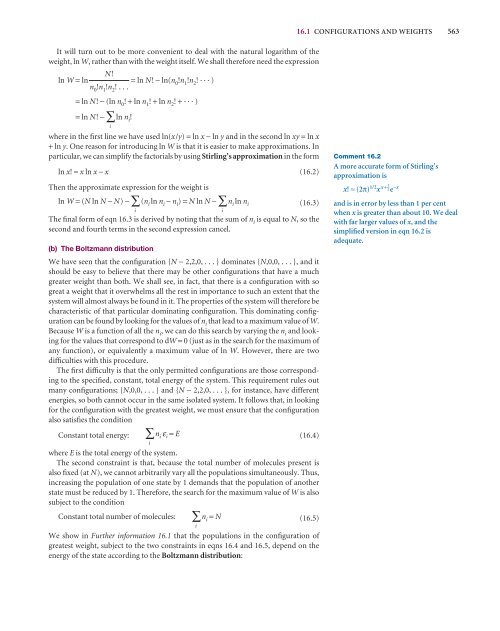Statistical thermodynamics 1: the concepts - W.H. Freeman
Statistical thermodynamics 1: the concepts - W.H. Freeman
Statistical thermodynamics 1: the concepts - W.H. Freeman
Create successful ePaper yourself
Turn your PDF publications into a flip-book with our unique Google optimized e-Paper software.
PC8eC16 1/26/06 14:34 Page 563<br />
16.1 CONFIGURATIONS AND WEIGHTS 563<br />
It will turn out to be more convenient to deal with <strong>the</strong> natural logarithm of <strong>the</strong><br />
weight, ln W, ra<strong>the</strong>r than with <strong>the</strong> weight itself. We shall <strong>the</strong>refore need <strong>the</strong> expression<br />
N!<br />
ln W = ln = ln N! − ln(n 0 !n 1 !n 2 ! · · · )<br />
n 0 !n 1 !n 2 !...<br />
= ln N! − (ln n 0 ! + ln n 1 ! + ln n 2 ! + · · · )<br />
= ln N! − ∑ln n i !<br />
i<br />
where in <strong>the</strong> first line we have used ln(x/y) = ln x − ln y and in <strong>the</strong> second ln xy = ln x<br />
+ ln y. One reason for introducing ln W is that it is easier to make approximations. In<br />
particular, we can simplify <strong>the</strong> factorials by using Stirling’s approximation in <strong>the</strong> form<br />
ln x! ≈ x ln x − x (16.2)<br />
Then <strong>the</strong> approximate expression for <strong>the</strong> weight is<br />
ln W = (N ln N − N) − ∑<br />
i<br />
(n i ln n i − n i ) = N ln N − ∑n i ln n i (16.3)<br />
i<br />
The final form of eqn 16.3 is derived by noting that <strong>the</strong> sum of n i is equal to N, so <strong>the</strong><br />
second and fourth terms in <strong>the</strong> second expression cancel.<br />
(b) The Boltzmann distribution<br />
We have seen that <strong>the</strong> configuration {N − 2,2,0, ...} dominates {N,0,0, ...}, and it<br />
should be easy to believe that <strong>the</strong>re may be o<strong>the</strong>r configurations that have a much<br />
greater weight than both. We shall see, in fact, that <strong>the</strong>re is a configuration with so<br />
great a weight that it overwhelms all <strong>the</strong> rest in importance to such an extent that <strong>the</strong><br />
system will almost always be found in it. The properties of <strong>the</strong> system will <strong>the</strong>refore be<br />
characteristic of that particular dominating configuration. This dominating configuration<br />
can be found by looking for <strong>the</strong> values of n i that lead to a maximum value of W.<br />
Because W is a function of all <strong>the</strong> n i , we can do this search by varying <strong>the</strong> n i and looking<br />
for <strong>the</strong> values that correspond to dW = 0 (just as in <strong>the</strong> search for <strong>the</strong> maximum of<br />
any function), or equivalently a maximum value of ln W. However, <strong>the</strong>re are two<br />
difficulties with this procedure.<br />
The first difficulty is that <strong>the</strong> only permitted configurations are those corresponding<br />
to <strong>the</strong> specified, constant, total energy of <strong>the</strong> system. This requirement rules out<br />
many configurations; {N,0,0, ...} and {N − 2,2,0, ...}, for instance, have different<br />
energies, so both cannot occur in <strong>the</strong> same isolated system. It follows that, in looking<br />
for <strong>the</strong> configuration with <strong>the</strong> greatest weight, we must ensure that <strong>the</strong> configuration<br />
also satisfies <strong>the</strong> condition<br />
Constant total energy: ∑n i ε i = E (16.4)<br />
i<br />
where E is <strong>the</strong> total energy of <strong>the</strong> system.<br />
The second constraint is that, because <strong>the</strong> total number of molecules present is<br />
also fixed (at N), we cannot arbitrarily vary all <strong>the</strong> populations simultaneously. Thus,<br />
increasing <strong>the</strong> population of one state by 1 demands that <strong>the</strong> population of ano<strong>the</strong>r<br />
state must be reduced by 1. Therefore, <strong>the</strong> search for <strong>the</strong> maximum value of W is also<br />
subject to <strong>the</strong> condition<br />
Constant total number of molecules: ∑n i = N (16.5)<br />
i<br />
We show in Fur<strong>the</strong>r information 16.1 that <strong>the</strong> populations in <strong>the</strong> configuration of<br />
greatest weight, subject to <strong>the</strong> two constraints in eqns 16.4 and 16.5, depend on <strong>the</strong><br />
energy of <strong>the</strong> state according to <strong>the</strong> Boltzmann distribution:<br />
Comment 16.2<br />
A more accurate form of Stirling’s<br />
approximation is<br />
x! ≈ (2π) 1/2 x x+ – 2e 1 −x<br />
and is in error by less than 1 per cent<br />
when x is greater than about 10. We deal<br />
with far larger values of x, and <strong>the</strong><br />
simplified version in eqn 16.2 is<br />
adequate.

















